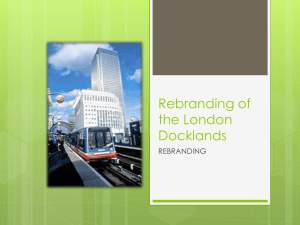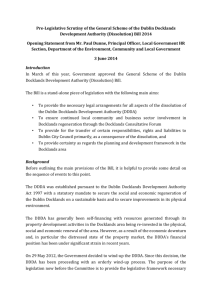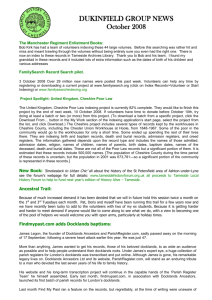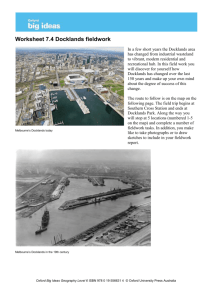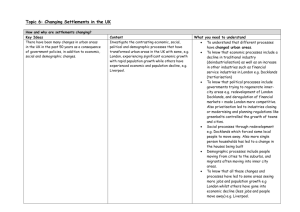Dublin Docklands Development Authority Community Liaison
advertisement
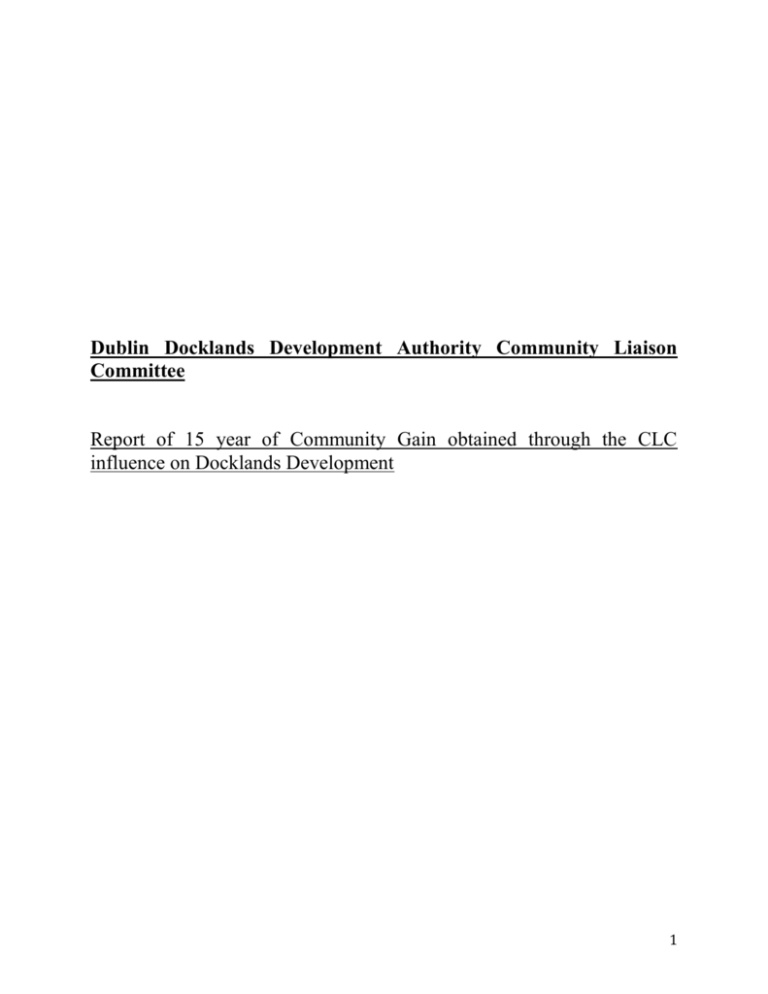
Dublin Docklands Development Authority Community Liaison Committee Report of 15 year of Community Gain obtained through the CLC influence on Docklands Development 1 Introduction Since its establishment in 1997, the Dublin Docklands Development Authority (DDDA) has driven the social regeneration of the Docklands community as a key part of its mission. From the start the community representatives of the DDDA Council recognised that while there would be a lot of development in the area they were determined that the project was not a bricks and mortar project, but a people's project. The representatives of the Docklands communities on the Council have insured that the opinions, needs and welfare of the local community were always kept top of the Docklands Authority's agenda and enshrined in DDDA policy. This report was compiled for and on behalf of the community representatives on the DDDA Council; this group is also referred to as the Community Liaison Committee (CLC). The remit of the CLC in addition to that of the Council membership is to maximise the benefits to the community sector through social and economic gain. The set of benchmarks for this report are based on the original clearly identifiable needs of the indigenous dockland communities which the CLC insisted were included in the Draft Master Plan 1997 housing, education and jobs. The community consultation process and the direct input by the community representatives on the Dublin Dockland Council over the last 15 years have insured that the community agenda was kept to the fore. The Docklands social regeneration programme has embraced the entire community with a customized range of programmes including community development, social infrastructure, housing, employment and education. Over the past 15 years the CLC has continued to reflect the needs of the Docklands community and has strived to achieve and maximise the benefits to the community through community gain. History For over 200 years the Docklands area both north and south of the quays was a thriving port related working class area. Along with the traditional port related industries such as boat building, rope making and general port related import and export industry other industries thrived in the locality. Labour intensive industries such as glass manufacturing, shoe and slipper making, flour milling and grain stores, gas production, metal foundries and coal import and distribution were the main industries; the work was manual, dirty, labour intensive and low paid. The advent of the containerization of cargo led to a dramatic loss of employment in Dublin Port. Together with the demise of the area’s traditional industries and the shift of manufacturing and distribution to new purpose build industrial estates on the outskirts of the city in the 1960’s resulted in the economic and physical decline of the Dublin Docklands Area. Along with the decline in population, shops and schools closed and in City Quay the community dwindled so low that it was known as ‘the dying parish’. Housing consisted of small artisan dwellings, tenements and large-scale local authority flat complexes. Most of these dwellings, including those owned by Dublin City Council (DCC), lacked basic bathroom facilities. The Dublin Docklands is comprised of five constituent residential communities: Sheriff Street/North Wall, North Strand and East Wall on the north side of the river Liffey and City Quay/Westland Row and Ringsend/ Irishtown on the south side. As 2 early as the late 1970s Dublin City Council’s strategy of depopulating the north inner city in order to facilitate redevelopment for commercial use engendered serious community opposition. Any agency charged with regenerating Dublin’s extensive Docklands in the late 1990s would have had to overcome deep-rooted distrust and resentment on the part of these communities arising from a long history of perceived neglect and ill treatment by DCC. The social and economic profile of the Docklands changed considerably during the 20th Century, resident communities more than halved in number to 17,400 living in 6,700 households by 1996. The local economy has undergone a fundamental restructuring within the last 30 years. Employment in port-handling activities declined dramatically with the advent of containerization and many of the traditional industries such as gas manufacturing, flour milling and warehousing have been lost from the Area. However, other industries have emerged and new service industries have located within new development in the Docklands, with financial services concentrating in the IFSC and George’s Quay. In 1997 there were over one hundred community organisations and groups in the area who had collectively played a crucial role in amelioration the decline in the Docklands area on the indigenous population. The Custom House Docks Development Authority (CHDDA) The forerunner of the DDDA was the Custom House Docks Development Authority (CHDDA) which was established under Section 8 of the Urban Renewal Act, 1986 and became the planning and development authority for the Custom House Docks area on the north side of the River Liffey. A range of financial incentives, including tax allowances, rates remission and rent allowances, were made available, in order to stimulate development. Over the ten-year period of its existence, CHDDA in association with various public agencies facilitated considerable office and residential development in the Custom House Quay area. A major flagship project, the International Financial Services Centre (IFSC) comprising 111,500 square meters, was developed. By mid 1997, 4,600 people were employed in the IFSC. This situation this situation represented a dramatic turnaround from the situation of just a decade previously. The relationship between the CHDDA and the local communities was problematic. This Authority’s remit was restricted to delivering the economic and physical regeneration of the area and did not deliver any tangible gains to the local communities: The failure of CHDDA to create housing or employment opportunities for local people within the new developments was heavily criticised by the docklands communities: In response to community pressure CHDDA established a Community Liaison Committee, and they selected certain community activists as representative of the indigenous docklands communities. The Community Liaison Committee was widely viewed by the community as a pacifier to the local people. The community activists included on the Community Liaison Committee felt that they had no power other than to make sure that the community’s views were heard by the decision makers. It was perceived that the committee was used as a vehicle to progress proposals by defusing conflict and protests and as a means for smoothing the way for economic regeneration with no benefits accruing to the local population. 3 The Dublin Docklands Development Authority (DDDA) CHDDA had been in existence for 10 years when it was replaced by a new Authority to take over its functions. Established under the Dublin Docklands Development Authority Act of 1997 this Authority covered a much larger area extending to 526 hectares on both sides of the River Liffey. The DDDA was responsible for the sustainable social, economic and physical regeneration of the Docklands in addition to the continued development of the financial sector of the economy and was required to prepare a master plan for achieving these objectives. This was perceived as a huge opportunity for the indigenous population of the Docklands to become involved in any future plans for the development of their community. It is against this policy background that the next stage of the regeneration of the Docklands area took place. Community-based Consultation In 1997 the CHDDA was replaced by the Dublin Docklands Development Authority (DDDA), which featured the statutory inclusion of local communities in the decision-making process. As a result there has been a high-level interventionist approach to social need with the local community contributing to solving their own issues (Dublin Docklands Development Authority, 2008). It is this inclusive approach to community-based issues that has led to the social and economic achievements that make the Docklands project unique and successful. The inclusion of seven community representatives on the 26 member Council of the DDDA was seen as a huge shift towards facilitating real community participation in the decision-making process for the area. In the 1997 Master Plan it stated that a high level of participation from local communities was critical to the implementation of the Plan. The establishment of the new authority was broadly welcomed by the community as the social regeneration of the Docklands was being promoted for the first time. This changed the whole picture from a community prospective because the DDDA now had responsibility for social development, as opposed to just physical development, as had been the case in the past. The main difference between the DDDA and CHDDA was the communities were directly involved in the decision making which insured the social agenda was enshrined into the master plan i.e. the social agenda is very much built into the fabric of the master plan, which is protected through legalization. The DDDA Council consists of 26 members, seven of which are community representatives. These seven members also make up the Community Liaison Committee. The CLC also allows the community another means of influencing decision-making as it is chaired by a member of the Executive Board this gives a direct input into the Executive Board. Community Participation The Master Plan for the Docklands which was published in 1997 and is reviewed every five years is underpinned by a similar statutory consultation process to the city development plan. The DDDA is required to advertise the Draft Master Plan, put it on display and invite submissions from the public. The broad provisions of the master plan must then be reflected in the city development plan which is subject to a separate consultation process. The DDDA also 4 has the power to formulate area action plans and Section 25 planning schemes with opportunities for the community representatives on the DDDA Council and the general public to have an input. The Master Plan comprises of broad strategic policies, while area action plans and Section 25 planning schemes include more detailed design specifications such as residential densities and building heights. There is a general perception within the community that the DDDA make every effort to promote community participation and consultation. There was limited interest within the community in participating in the initial formulation of the Master Plan this was largely due to past experience with CHDDA. Many people would not participate because they felt that the DDDA was just paying ‘lip service’ to community. While the community representatives recognized that their participation was taking place within a commercial framework and felt that their role was to maximize the benefits accruing to the community from investment in the Docklands. Social Regeneration Conference In order to assure that the needs of the community where being fully identified and to give them a opportunity to express their thoughts or ideas and to have a genuine input into decision making, the CLC initiated Docklands Social Regeneration conference, which was held on an annual basis. The conference is seen as highly beneficial in promoting community participation and building consensus between the different Docklands communities. It was facilitated by the community leaders, the topics for discussion were chosen by the community and the CLC members chaired the sessions. The community people were given an opportunity to raise the issues that was of concern to their groups. The conference was also about, networking with other similar groups, making new friends, as well as having the opportunity to listen to guest speakers from both Ireland and international countries. Part of the success of the conference was its location taking the representatives of the groups out of the city meant there would be fewer distractions and guaranteed a full attendance at all sessions. The reports were fully inclusive and set targets that were to be met over the following year as well as the full details of the issues of concern for the community. The CLC members were subsequently charged with ensuring the implementation of the recommendations agreed at the conference. A number of forums were set up from the recommendations at the Conference which allowed focus groups from the organisations from across the Docklands to meet, identify common concerns and provide support for each other. One of the first forums was the School Principles forum with representatives from all Docklands schools. Also established by the DDDA were the Childcare Forum, the Youth Forum, Housing Forum, Docklands Seniors Forum, Docklands Business Forum, Docklands Young Peoples Forum and Docklands Senior Service Providers Forum. The DDDA have been successful in attaining a method of facilitating consultation with local communities. Housing From the 1960s onwards the outward migration of Dubliners to the suburbs became the choice for most families due to the suburbs accompanying facilities and factories. This outward 5 population sprawl led to the rapid physical, social and economic decay of the inner city. In contrast to the emerging leafy suburbs with individual dwellings, the local authority housing in the Docklands area was characterized by a lack of open spaces, recreational amenities or even basic sanitation facilities in some cases, as well as being surrounded by heavy industrial derelict sites. The majority of housing in the area was built between 1930 and 1952 for Dockers. After that occupation declined, a large number of families moved out. The local authority placed ‘at risk’ families from other areas of the city into these vacant apartments. This resulted in an unbalanced social profile of residents in the area. Indeed, by the early 1980s, more than half of the housing in the area was over 70 years old and of poor quality. All these factors resulted in the Docklands area becoming characterized by poverty and dereliction on a much larger scale than other parts of the city (Moore, 2008). The communities, though sparse in numbers, had been mobilized for a number of years to seek the rejuvenation of their area which was fading with a dwindling population, lack of suitable housing, job opportunities and relevant services. In an attempt to rectify this in the first Master Plan (1997) the CLC clearly identified the need for education, housing and employment as a major priority. The DDDA was reluctant to yield to the community representatives’ demand for 20% social and affordable housing due to concerns regarding the financial attractiveness of the Docklands for redevelopment. The CLC refused to sign off on the Master Plan unless their priorities were enshrined in the document. DDDA Housing Policy The 1997 Master Plan proposed to support a significant expansion of the residential base of the area, cater for the development of social and affordable housing to meet the foreseeable need in the area. This was to be located throughout the area allocated for residential use at a minimum average of 20% of all new units. This housing policy was entitled Section 25 Housing and differs from the Part V Housing which was introduced in the Planning and Development Act 2000. Section 25 housing states that 20% social or affordable housing must be built in all residential developments as this will contribute to a good social mix in the community. Since its establishment a total of 3,335 residential units have been built in the Docklands area. 409 of these units are social /affordable and a further 405 social/affordable units have been certified under Section 25 and another 814 certified and awaiting development. (DDDA Annual Report 2010) Funding for social housing comes through the Housing Finance Agency (HFA), an independent body under the aegis of DOEHLG whose function is to provide funds to local Authorities to enable them to undertake their function under the Housing Acts. The HFA provides the funds to Housing Associations to purchase housing units. Once a housing association is approved by DOEHLG they then become eligible for funding including management and maintenance. These housing associations were relatively new phenomena to the Irish housing market as was management fees and maintenance. New housing associations appeared to mushroom up all over the city, the majority of these having their origins in the United Kingdom. The Local Authority remained the Housing Authority and their function was to 6 allocate housing from its housing list. After the first allocation of Social housing in the Docklands, the CLC became aware of a number of serious issues with the model of housing management within the Docklands and raised the issue at a CLC meeting and the full Council Meeting. It was also brought to the attention of the Minister of Environment at the time. The lack of governance for and within the housing associations was a serious omission. These associations were in fact social landlords and would after a period of time own the property which meant they could dispose of the properties as they wished. These ‘landlords’ could also increase rents and increase management and maintenance fees without first consulting with the residents of the units - this would prove to be unsustainable for the community. Housing trust Several years later, the debate was still continuing regarding the long-term management of the social-rented units. Serious misgivings regarding housing association ownership and management of the social-rented housing stock in the Docklands have led the community to lobby for the establishment of a tenant-controlled housing trust. Similarly delays in introducing government policy to regulate housing associations and housing management companies prompted the CLC to set up a Housing Trust for the long-term sustainability of housing in the Docklands. The Docklands Housing Trust was established in 2007 and will insure that the management of social housing stock will remain with the community even after the Docklands cease to exist. Prior to the establishment of the Docklands Housing Trust the CLC members lobbied the DDDA Council and Board to insure that all management contracts for the new social-rented housing stock would be limited to five years with a view to capacity-building among the residents and the establishment of a tenant controlled housing trust. Eventually it was agreed that the management contracts to housing associations where to be three to five years in duration. The DDDA also introduced a new form of integrated area management. This management system covers all areas including houses, play areas and public realm within all new complexes after 2007. Employment The Dublin Docklands Development Authority policy states that 20% of new jobs created in the docklands will be on offer to residents of the docklands in the first instance and thereafter in its hinterland. This proportion can be divided into full-time jobs and apprenticeships. “The DDDA accepts that this policy is dependent on the availability of appropriate skills in the area. The Authority will work to provide the necessary training and education to rectify identified skills shortages.” (DDDA, 2003, 103) Docklands Community Local Labour Charter The Local Labour Charter was established by the Docklands authority to ensure that local people get their fair share of employment from the many projects in the area. The Charter specifically 7 seeks to help local communities by reducing the number of unemployed people in the Docklands area. Included in the DDDA master plan 2003 was a proposed action plan to insure that the 20% local labour clause was met. This policy included the appointment of a Labour Liaison officer (LLO) and the establishment of an “on-site” local labor central office. The remit of the LLO included the maintenance of a database of skills required by employers starting up new company’s' and existing businesses in the area and also stated that the DDDA would maintain a database of skills required by developers and contractors. In order to contact school leavers at an early stage to help place them in further education or employment the DDDA maintained a database of school leavers and of the training needs of the locally unemployed. In conjunction with the local Local Employment Service, FAS and Cert a range of training and development programmes were established. Since the establishment of the Local Labour Charter 20% of all construction jobs on projects undertaken within the Docklands Authority's remit have to be filled by local people. The Docklands Local Labour Charter has been successful in providing many construction jobs for local people for example on the 2nd phase of the IFSC development 120 local people were employed and 90% of these had been on the long-term unemployment register. On the Spencer Dock and Grand Canal Harbor development the 20% stipulation also applied. When this is compared with the first development stage of IFSC it was a marked improvement. Young Persons' Self Development Programme The Docklands Authority introduced the young person’s self-development programme to help young people obtain the skills they need for successful employment. The programme is targeted at those who have completed the Leaving Certificate and may not be interview ready. This two day course is to improve job seeking effectiveness and associated skills and is focused at building the person’s interview confidence and helping them understand what is expected by them in a work environment. Additionally, most of the participants who complete the course go on to obtain full employment. School Jobs Placement work Students who do not wish to go on to further education and opt to leave education at the Leaving Certificate stage often find it difficult to get their foot on the employment ladder. For this reason the job placement programme was initiated. Working with FAS the DDDA liaised with companies throughout the Docklands area to obtain entry office positions suitable for Leaving Cert. students. This provided a fantastic opportunity for the young locals to gain experience into the world of work, particularly in the financial services sector, which gave them a great overview of the finical industry and also training in the European Computer Driving License (ECDL). This proved to be a very successful programme as many of the students were offered full time permanent positions after the original 12 month contract, even if they were not offered further employment they still leave having real marketable skills and experience allowing them to compete successfully for other jobs and ultimately develop their careers. 8 Community Training Workshop In 1999 the Docklands Authority provided a purpose built community training workshop to house the facilities and equipment for a wide variety of courses which would improve the skill set of the local community. These workshops provided a variety of skills including IT skills, painting/decorating, office skills and sewing and dress design. The locals also benefited by identifying and developing their own courses and training programmes. The issue of local jobs has always be contentious within the community and following an indepth discussion at the Docklands 2008 Social Regeneration Conference it was decided to establish a Docklands Local Employment Forum (LEF). The forum was established by the DDDA in partnership with the Local Employment Services and community leaders to facilitate a partnership approach to increase the number of new job placements in Docklands. Apprenticeship Programmes Entries into apprenticeships have traditionally been difficult to gain access to in Ireland. Often experience, training and access to courses were passed from father to son in the traditional skills such as carpentry, bricklaying, plumbing and mechanics. The people of the Docklands did not always have access to training nor would they have reached the required education levels to serve an apprenticeship. The Docklands initiative helps those who wish to pursue a skilled trade but find it difficult to secure an apprenticeship Docklands works with a number of trade’s people and their representative’s organisation to place aspiring young tradesmen and tradeswomen from the Docklands in appropriate apprenticeships. This programme has successfully placed young Docklanders in carpentry/joinery, plumbing, plastering, painting, decorating and bricklaying apprenticeships. Enterprise Development Programme The Enterprise Development programme was created to meet the needs of local self-employed business people and to raise the level of interest in becoming self-employed. There were a number of elements to the programme including the establishment of local Enterprise Office Units in East Wall which are made available to local entrepreneurs at reasonable rates. An Enterprise Forum was also established and training was provided at a number of levels to business, community and schools. The combination of these activities has resulted in the establishment of an environment where local enterprise is encouraged and developed. Docklands Community Local Labour Forum Local employment for local people has always been at the forefront for community leaders in the Docklands and following an in-depth discussion at the Social Regeneration Conference 2008 it was agreed that a Docklands Local Employment Forum (LEF) should be established by the DDDA in partnership with the local employment services and community leaders to facilitate a partnership approach towards increasing the numbers of new job placements in the Docklands. The LEF is open to all formal and informal local employment services and support providers 9 operating within the Docklands catchment area. Its membership is drawn from local employment groups, Saint Andrews LES and the Inner City Renewal Group, FAS, Social welfare, local community representatives, local business representatives, new community representatives and the DDDA. Through this partnership approach it is intended to maximize the job placements for local job seekers. The Docklands LEF established a set of tasks which would inform the agenda for each meeting, which takes place on a monthly basis. Identify current business leads that can be approached by the forum in a coordinated fashion with a view to building up the stock of current available job. Identify long term opportunities and develop lead-in strategy to maximise attractiveness of local job seekers to future employers, through training, mediation, pre-interview screening and active relationship building Each member group of LEF was required to furnish a list of future business contacts for the month ahead, which will then be reviewed and the members are allocated with a number of businesses to contact. In 1997 not one local person was employed in the IFSC, there are now over 300 young docklanders working there. These are highly skilled jobs and include working on the trading floors and in administration. Furthermore these jobs do not include the number of young people who secured employment in other sectors around the Docklands. The economic down turn in recent times means the jobs secured in the construction sector have collapsed. As this is a temporary null in the rejuvenation of the Docklands it is hoped the education and work experience gained on construction sites as well as serving time in apprenticeships will contribute to local people becoming ready to enter the labour market when it returns and in the mean time they have the skill-set to seek employment outside the Docklands. Education and Training The DDDA’s states its mission is to “create a paragon of sustainable inner city regeneration” additionally its objective is to ensure that “the whole community enjoys the highest standards of access to education, employment, housing and social amenity” (DDDA website). Investment in education is considered by the authority to be the foundation of social regeneration, and the Dublin Docklands Education Programme that has been implemented by the authority at primary, post primary and third level education is designed to bring fun and passion into school life, encouraging participation and improving future prospects. (DDDA website). The Docklands was characterized by high rates of early school leaving, the indigenous communities were ill equipped to take advantage of employment in the financial services sector which had been created in the CHDDA years: The remit of the DDDA covers not only the physical transformation of the Docklands but also the social regeneration of the area, with the aim of improving education, employment, community development, civic infrastructure and housing in the Docklands communities north and south of the Liffey. Since 1997, the Social 10 Regeneration Unit of the DDDA funded and provided the Dublin Docklands Education Programme for schools and communities in the Docklands and its immediate hinterland. The Programme has included more than forty different projects and activities over its lifetime to date. In 2007 the Social Regeneration Unit on behalf of the Authority commissioned education consultants to undertake an evaluation of the DDDA education programme. This report was compiled by Professor Áine Hyland of University College Cork and Cynthia Deane of Options Consulting. The report presented both an evaluation of the Dublin Docklands Education Programme (based on its achievements in the period from 1997 to 2007) and a strategy for the future development of the Programme. The strategy, which was developed in collaboration with the schools involved in the programme, build on the extensive experience gained not only within the Dublin Docklands Education Programme but also elsewhere in Ireland and internationally and aims to consolidate successful practice and create a new platform for progress in the future. The various projects and activities have added value to the work of schools and to the education service in Docklands communities. Involvement in the Education Programmes has raised the morale of school communities, by valuing people and their work. The projects and activities have been effective in helping schools to achieve their goals. Within the Dublin Docklands Education Programme, there is a wide range of projects and activities that have produced significant benefits, a more varied curriculum and support for pupils’ learning, greater access to the arts and culture in schools and communities, varied sports and leisure opportunities, improvements in pupils’ motivation and behavior, relevant and high quality professional development for educators, research on the educational profile of the area, support for school development both organisational and infrastructural and the involvement of parents and young adults in community-based Programme activities. In tandem with the evident physical changes in the Docklands there is a less visible but equally important transformation taking place – the social regeneration of the Docklands communities. Investment in education has been the cornerstone of the Authority’s Social Regeneration Programme since 1997 with a wide range of educational development projects at primary, post primary and third level. The projects have been designed in conjunction with the twenty-four local school principals to bring fun and passion into school life, encouraging participation and improving future prospects for young The Programme activities can be grouped into a number of categories, curriculum enrichment and learning support, arts and culture, sports and leisure, motivation and behavior enhancement professional development for principals and teachers, research, school development, organisational and infrastructural, and community-based projects and activities. Dublin Docklands Education Programme Curriculum Enrichment and Learning support • Psychological Assessments • After-School Study Programme • Twinning with EU Schools French Programme • Literacy Programme 11 • Early Start Education • African IT Programme • One World • Life centre Project Sports and Leisure • Soccer Academy • Gaelic Football and Hurling Academy • Boxing Academy • Docklands Schools’ Festival (Dragon Boat Racing) • Sail Training Pilot Project • Splash Week • PE and Healthy Eating Programme Professional Development and Networking for Principals and Teachers • School Principals’ Forum • Teachers’ Conference • Teachers’ Dyslexia Development Programme • Play Therapy Course • Circle Time Teacher Training Programme • Emotional Intelligence • Study Bursaries for Teachers School Development: Organisational and Infrastructural • Docklands Schools IT Hub • Comer Whole School Development Programme • In-Schools Projects (Infrastructure and Building Development) Arts and Culture • Schools’ Music Programme • Caught on Camera (Schools’ Photographic Initiative) • Schools’ Drama Programme • Honk (Musical Production) • Sound School • Drama Academy and Schools Theatre Festival • School Bands Motivation and Engagement • Circle Time • Therapeutic Crisis Intervention Management • Schools’ Incentive Behavior and Attitude Programme • Third Level/Further Education Scholarship Programme • Discovering University 12 Community-based Education Programmes • Family Learning through Coaching • Young Achievers’ Awards • Schools Job Placement Programme • Active Citizenship Programme • Parents in Education • Apprenticeship Programmes • Local Employment Initiatives • Safe Pass training Research and Publications • ESRI Schools’ Survey and Database • Schools’ Yearbook • Study Visits to Models of Best Practice. In conclusion, the impact of the education programmes has resulted in more young people in the Docklands completing second and third level education, with improved levels of achievement especially in literacy, numeracy and Leaving Certificate results. Families and community are more actively involved in supporting education and training and a commitment from the DDDA to support all aspects of education from the cradle to the grave. The Dublin Docklands Education Programme has created awareness among teachers, parents and pupils of the substantial educational supports that are available to people living in the Docklands area. The project activities have broadened the children's horizons and expectations by exposing them to new experiences and by giving them opportunities to develop their talents and explore possibilities for the future. Their self-esteem is enhanced and teachers believe that this has produced positive effects on their learning. The Dublin Docklands Education Programme should continue to foster high aspirations and ambitions among the Docklands communities, and should support schools and families to realize their dreams. It is a fundamental principle of the Dublin Docklands Education Programme that education has a significant and enduring effect on the lives of children, and that schools make a difference. International research suggests that effective schools can be up to six times more important than background in children’s reading performance and up to ten times more in mathematics. Where schools and teachers set realistic goals for improvement in specific areas, they can transform the lives of learners and communities. Schools in the Docklands are already making a huge difference. Community Gain Government documents, clearly state that the key aspect of “community gain” is that it offers a proportionate benefit for alleviating the inequity and perceived losses incurred when proposed major infrastructure is planned for its locality. Internationally, ‘community gain’ has been implemented in one of three forms: community gain, planning gain or host community benefit. Whichever it’s precise form, the studies show that the key to the concept of community gain being successful in the building of consensus are negotiated agreements between the local 13 communities affected and the developers who will be in charge of development of an area. The Docklands community gained is delivered under all three forms and the interdiction of the Community Development Project Initiative (CDPI) enabled community groups and organisations to identify and undertake their own projects, with the support of the CDPI funding. Community Development Project Initiative (CDP1) The CDPI was introduced in 1999 after the CLC members lobbied the DDDA to introduce funding for community benefit to enable community groups and organisations to undertake projects. The year following the request the DDDA introduced the Community Development Project Initiative (CDPI). Under this programme community groups can apply for 60% grants for approved non-commercial/non- profit community projects. This leveraged over 10 million euros which was invested in the community in the first 8 years alone. Some of the functions provided in local community groups include primary and secondary level educational assistance, community development and training, parish work, crèche and playgroup facilities, sports and youth volunteers, community credit, enterprise and employment resources and recycling enterprises. This entire sector was assisted by funding through the CDPI. Over the past 15 years the Docklands has seen vast changes, both physical and social. During this time a number of new community facilities have been established or up graded. A civic infrastructure audit review undertaken in 2006 by Colin Buchanan (CB) commissioned by the DDDA found that the number of community facilities increased from 19 to 207 between 2004 and 2006 and these were found to be in adequate working order and accordingly should be incorporated and where necessary upgraded to ensure maximum community benefit. The CB audit also highlighted the need for various facilities such as community centers, libraries, churches and health facilities. It also highlighted the need to develop facilities to incorporate the accommodation of community training, crèches and subvention enterprise space in addition to facilities for youth and senior citizens. Docklands Community Trust The CLC Members lobbied hard for the establishment of a community trust for the long-term sustainability of the Social Regeneration within the Docklands. To address this concern the DDDA set up the Docklands Community Trust. The initial endowment of 1.2million euro kick started the trust and in the years since this initial capital sum has been built on. The intension of the trust is to provide for the on-going running of some current programmes after the DDDA ceases to exist and the funding is safely invested on behalf of the communities. Three members of the CLC are Directors on this committee. 14 SUMMARY It is acknowledged the regeneration of Dublin Docklands was effective as a result of real participation and cooperation by the community representatives nominated to represent their communities on the Council. They brought the issues existing on the ground and highlighted the deficit, in community infrastructure, education, housing and employment to the Council table in a constructive and problem solving approach. The fact that four of the community representatives have served for 15 years on the Council brought continuity, commitment and motivation to ensure that the momentum of the Social Agenda was always to the fore. Those of us who did serve the 15 years feel strongly that continuity will be the key to maintaining this momentum to consolidate the ongoing regeneration of the neighbourhood of Dublin Docklands. In order to develop a sustainable community in the Docklands it is necessary to ensure that the community continues to benefit from on-going development through community gain which will ensure entitlements and improved quality of life for local people and the capacity for selfactualization. Planning in the recent past has become synonymous with the term ‘developer driven’. This may have been so in the recent past but the inclusion of the CLC members on the DDDA Council has insured that the Docklands Development Policy was also very much community driven and aimed to obtain the maximum benefit for the indigenous local communities. The community representatives on the DDDA rated their success in community gain very highly and believe that their representation on the Council of the DDDA had a strong influence on outcomes: It is an on-going challenge to ensure that the social agenda is delivered and in these stringent times it is all the more necessary that we secure the greatest benefits for the community. As a result, there has been a high-level interventionist approach to social need, with the local communities playing a crucial role to solving their own issues. The transformation of the Dublin Docklands is an on-going process which will take far more than the 15 years envisaged by the original vision. Although many changes have taken place, the indigenous dockland communities have managed to retain their identity and sense of place while embracing new communities. Docklands must continue its evolution into a vibrant city quarter, with a thriving mix of business, social life and homes. It is already characterized by its own identity and a sense of place and it is recognized as cosmopolitan, urban and modern, and that the area will continue to be a world class study in social regeneration. Pre DDDA, decline and neglect was across the board in dockland communities and mistrust of any plans for regeneration existed. For regeneration to be successful this lack of trust had to be addressed. The inclusion of 7 community representatives active in the 5 distinct community areas both sides of the river was the beginning of including and linking the communities to the economic and physical growth of docklands. Community organisations through their representatives collectively played a role in the regeneration. For regeneration to be effective the partnership between the local groups, the Authority, local businesses and statutory agencies provided a strong basis for collaboration and cooperation to successfully address regeneration. These positives did not just happen but required cooperation from the existing community groups who for many years had been struggling to survive. While it is acknowledged widely that the model of regeneration of Dublin Docklands was a ground breaking model and many positive 15 benefits have been achieved there still remains deep seated structural problems within communities which need to be continually addressed. Many of the benefits gained were through the construction phase. The physical development may be on hold and the challenge now is to replace the lack of construction opportunities with sustainable jobs. Sustainability will require all the strategies of regeneration to continue and linking the communities to these strategies is vital. This Report was compiled by Council Members Seanie Lamb, Charlie Murphy, Dolores Wilson, Betty Ashe and former Council Member Frances Corr. 16
